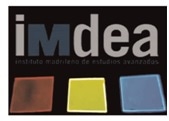Nov 6 2019
A collaboration between IMDEA Nanociencia and Nanjing Tech University researchers produces flexible, transparent and cost-effective lasers.
 Three distributed feedback structures illuminated by an UV lamp. Image: Juan Cabanillas-González.
Three distributed feedback structures illuminated by an UV lamp. Image: Juan Cabanillas-González.
The interest in plastic electronics and photonics has experienced a significant increase in the last decades due to the exceptional optical, semiconducting and mechanical properties of these materials. Plastic electronics, based on conjugated polymers, combine the benefits of cost-effective processability, compatible with large-area deposition for designing laser geometries of virtually any shape, not possible with rigid inorganic semiconductor materials. These highly luminiscent materials have been incorporated into a variety of resonator geometries, such as photonic crystals or distributed feedback (DBF) cavities, to enable optically pumped conjugated polymer lasers with emission across the visible and near-infrared spectrum.
A collaboration between IMDEA Nanociencia and Nanjing Tech University researchers have produced novel transparent, all-polymer DBF lasers. The DBF lasers make use of the periodic wavelength-scale nanostructures to backscatter photons for constructive interference. In their work, DBF structures were nanoimprinted on thermoplastic (cellulose diacetate) films and covered by highly luminiscent conjugated polymers. In this way, the designed lasers present an homogeneous emission in the blue, green and red colours. Besides, the emission wavelength is tunable by bending the DBF flexible cavities.
The advantages using thermoplastic materials such as cellulose diacetate as substrates are many: it is cheap, readily available, flexible and transparent even upon annealing. Also, cellulose diacetate is compatible with several organic solvents, it is obtained from renewable wood pulp and it is biodegradable. Researchers have demonstrated the robustness of their structures by assessing the lasing threshold values upon bending, confirming that the optical and structural properties of the active layer do not deteriorate.
The followed strategy is scalable and versatile. DBF lasers have currently a wide range of applications as mechanically flexible lasers, for instance, on lab-on-a-chip devices in biomedical analysis, information technology and sensing.
This work is a collaboration between " Organic Photophysics and Photonics" group led by Juan Cabanillas, "Nanostructured Functional Surfaces" group led by Isabel Rodríguez at IMDEA Nanociencia and Ruidong Xia from Nanjing Tech University, together with Daniel Granados and José C. Castro (IMDEA Nanociencia). The work has been partially funded by the Spanish Ministry of Economy, Industry and Competitiveness, the Regional Goverment of Comunidad de Madrid and the Severo Ochoa Programme for Centres of Excellence in R&D, awarded to IMDEA Nanociencia.